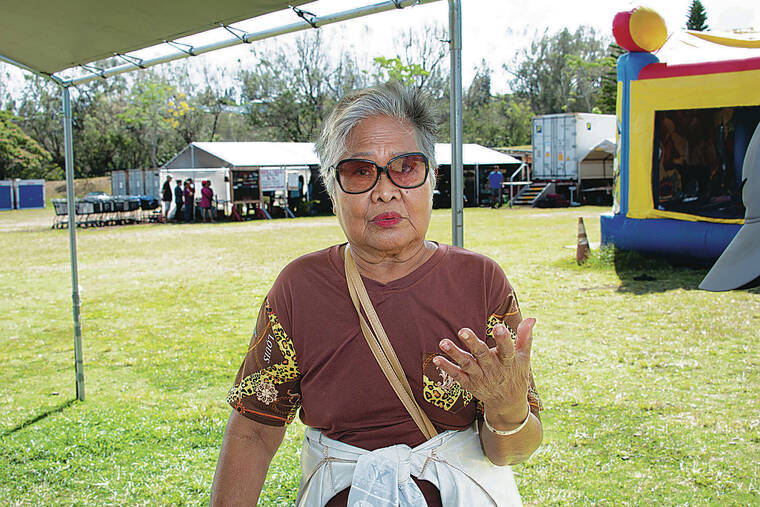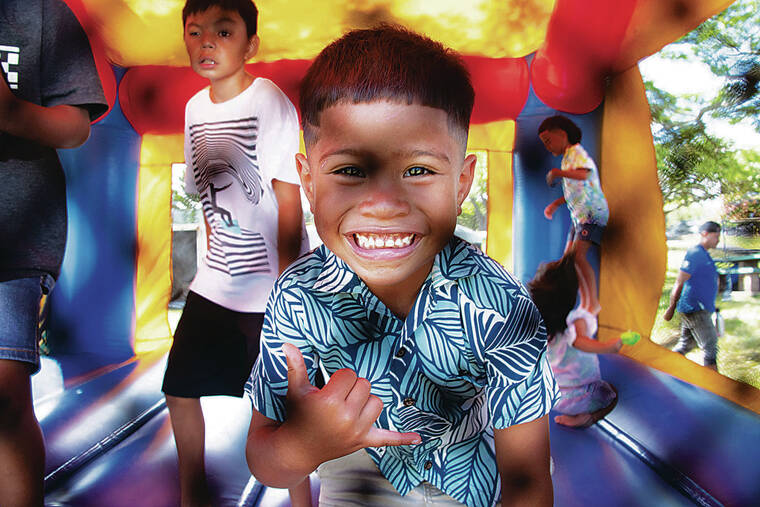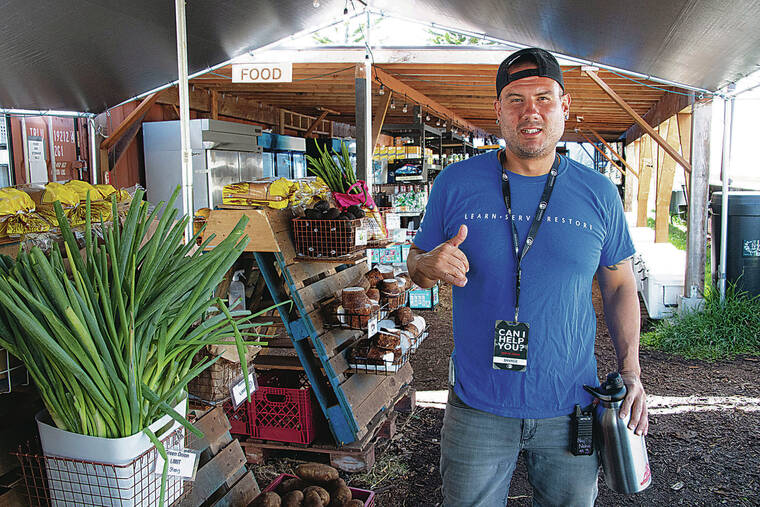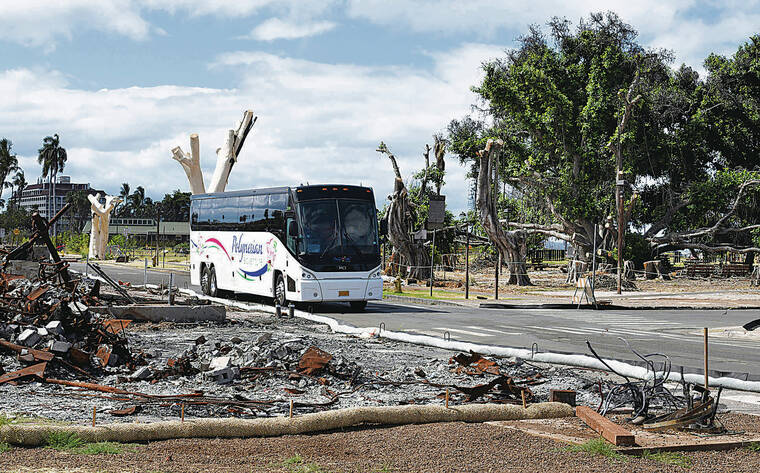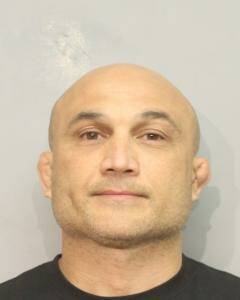Emotions running high as Lahaina fire anniversary nears
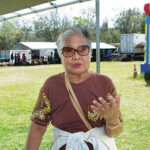

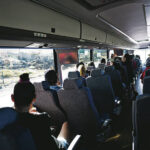

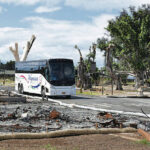
LAHAINA — The need for staples including bottled water, toilet paper, diapers and food has only increased since the Aug. 8 Maui wildfires, and so have the emotions and uncertainty as the island prepares to mark the one-year anniversary since a wind-whipped firestorm tore across Lahaina, killing at least 102 people and leaving two still missing in the nation’s deadliest inferno of its kind in over a century.
Maui County organized three days of trips into Lahaina so residents can see for themselves the efforts to clean up and rebuild their community.
ADVERTISING
The trips conclude today, followed by nine events starting Aug. 8 collectively called “Kuhinia Maui.” Maui County Mayor Richard Bissen has said the “week of remembrance with reverence and hope” takes its name “from a line in a traditional Maui chant that proudly speaks of the unequaled beauty and richness of Maui, highlighting that Maui and its people will rebound from tragedy.”
The events are scheduled to begin Aug. 8 with a community paddle-out of an expected armada of canoes, surfboards and anything else safe to float and a private gathering at the 3,000-seat Lahaina Civic Center later in the evening so residents can collectively grieve and honor those who died and remain missing.
Two of the events are being held in Upcountry Maui, where nearly two dozen homes burned in a separate wildfire Aug. 8.
In all, “Kuhinia Maui” likely will provide a communitywide catharsis — along with a reminder of the long road ahead and a growing awareness that the proud Lahaina community that was once the seat of power for the Kingdom of Hawaii may be forever gone, said state Sen. Angus McKelvey, (D, West Maui-Maalaea-South Maui), who lost his own home in Lahaina to the fire.
“Heck yeah!” said McKelvey when asked if he’s feeling the same swirl of emotions. “I’m going through it myself. People won’t be back in their homes any time soon. That’s the general consensus of most people one year later. As you get closer and closer to the anniversary, for me, it’s triggering. I wouldn’t be surprised to see an uptick in frustration toward visitors.”
Part of the mourning includes the nearly daily reminder that so many longtime and lifelong Lahaina residents have been dispersed around Maui or moved to other islands or the mainland in order to find any kind of housing — let alone homes they can afford and jobs — as landlords drive up rents in West Maui while the tourist-driven economy continues to struggle.
Mona Stevenson, a lifelong Lahaina resident who described her age as “kupuna,” boarded the first 50-seat bus that left the Lahaina Civic Center at 8 a.m. Friday to visit the burned areas.
“The town is gone,” she said upon returning. “It was devastating to see the places where I walked my whole life. Everything we had is gone.”
Stevenson and her family were among the first Lahaina residents allowed back to visit to their properties under strictly supervised conditions. At that time she was able see what remained of her mother’s duplex on Kuuipo Street where Stevenson and her family lived, but Friday represented her first opportunity to view what remains of the area as a whole, a trip she was grateful that county officials organized.
For others who may be overcome with emotions they may not be prepared for, Maui County officials included grief counselors on each bus ride into Lahaina, according to county spokesperson Mahina Martin. There are also counselors on hand when they return to the Lahaina Civic Center.
Even before Friday, several residents who registered for the trips later canceled, then re-scheduled.
“It’s very emotional for them,” Martin said.
In a statement Saturday, Bissen told the Honolulu Star-Advertiser: “We are humbled and grateful to be able to offer these rides for Lahaina residents so they can see first-hand the progress being made. I’m especially thankful for our Kuhinia Maui event team and community volunteers for their work organizing the rides.”
• • •
Immediately after the fires, community members quickly set up distribution centers around West Maui to disperse daily basics that survivors continue to need.
But as distribution centers have closed over the past year, the need continues and the number of families showing up every day at the Napili Noho distribution center at Napili Park has more than doubled to 250 per day, said one of the organizers, Shauna Dunn.
“The rents have gone up so much and the need has only increased,” Dunn said after people began lining up at 7 a.m. for the 9:45 a.m. opening. “It is shocking.”
Many of the volunteers and organizers lost jobs themselves and they, or their families, also had homes damaged or destroyed.
Napili Noho has since grown into a community gathering place of its own, where survivors meet and talk story about what’s happening to them and their families, said Harli Kala, who’s in charge of logistics.
Both volunteers and people picking up supplies bring their children every day to the park, where each week there are offerings of ukulele lessons, a bookmobile, an inflatable jumping house, mental health counseling and other activities organized by the Boys &Girls Club.
It’s also important for the children of both survivors and those volunteering to see the people of West Maui pulling together to help one another, Kala said.
“It’s important to show them responsibility,” she said.
Volunteers are encouraged to allow residents time to pick out donated items and talk to one another, said another organizer who identified himself as “Savage, just Savage.”
He was living in Las Vegas and volunteered to join a contingent from his Calvary Chapel congregation in October to come to Lahaina to help. While his fellow congregants have since returned to the mainland, he continues to live in a tent on the edge of the park at night.
Savage said he grew up in a Dakota Sioux reservation and instantly felt at home in Lahaina helping people of Native Hawaiian and Polynesian descent, along with others still struggling to recover from the fire.
“For those who faced colonization, I come from that,” he said. “This is very similar to my family. God called me to be here.”
• • •
At the age of 78, Angelina Dagupion simultaneously represents those in need and those willing to help.
Almost every day, she brings homegrown vegetables to donate to others while picking up donated staples, including bottled water, for herself and her family.
As a way of showing her gratitude to the volunteers, Dagupion also brings homemade pancit and banana lumpia.
Her eight-bedroom house, located on the edge of Lahaina’s main burn zone, had its roof blown off in the fire but she and her “very large family” have since been allowed to move back in.
Like uncounted families in Lahaina, Dagupion’s house served as a home to her and her husband, William, and their son’s family that includes three children. It was also a source of income by renting out a four-bedroom section of the home to tenants.
In all, she has 10 children, 24 grandchildren and eight great-grandchildren who were all living in Lahaina but have since spread all across Maui, including some still living in West Maui hotels and looking for jobs and permanent housing.
“Before,” Dagupion said, “everybody in Lahaina. Now everybody all over.”
As she left Napili Noho with toilet tissue, paper towels, canned goods, bok choy and other produce, Dagupion said she and so many others continue to rely on donated food and staples “because my money not enough. This very important. We’re so happy to have this. God helping us.”
She and her husband are retired after working as Lahaina resort housekeepers.
Grace Langdon, 22, lost her rental home in the fires then volunteered at the distribution center until recently, when she needed to earn steady income as a restaurant server.
The volunteer work, Langdon said, “was very draining. Everybody was tired all of the time. But it was the best thing I could have ever done.”
As Aug. 8 approaches, Langdon’s been experiencing “a lot of mixed feelings” and isn’t sure what to expect when she has to report to work on the anniversary of the disaster.
“I’m not excited about that because everyone’s going to be asking about it,” Langdon said. “Nobody wants to work that day because there are just constant reminders.”
So lately, Langdon’s been thinking of moving to Oahu to find work in a new community where the aftermath of the fire isn’t talked about every day.
“There are just constant reminders everywhere and people keep moving away,” she said. “I feel like I’ve done as much grieving as I can and it’s time to move forward.”
Before she rode into Lahaina on the second bus trip of the morning on Friday, Sumithra Balraj, 61, said she already “was emotionally drained” after her condo was left standing but so badly damaged it’s uninhabitable. She’s still required to pay the condo’s monthly association dues.
Balraj reluctantly sought counseling in May and is now glad she did, “so I can move forward.”
During Friday’s bus ride, everyone on board spoke in hushed tones or not at all as they worked to pinpoint once familiar landmarks.
“It was very, very quiet,” Balraj said. “I really appreciated that they gave us that ride for us so we could see it in person. I was looking for some form of closure but it didn’t give me the closure I needed. I think it’s going to take a long, long time for anything to resemble a form of normalcy.
“Most of Lahaina was pretty much gone. It’s going to be a pretty long process and most of the businesses won’t come back for five to 10 years.”
After getting her first in-person view of the devastation, Balraj remains more convinced than ever that she’ll have to move somewhere outside of Hawaii and start over.
“I’ve lived on Oahu but it’s not the same as Lahaina,” Balraj said. “That’s the town I lived in. Lahaina was the perfect place.”

